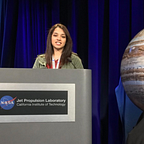Why Titan could be an Early Earth
Series: Moons of the Solar System
Titan is our solar system’s second largest moon. It is nearly one and a half times the size of our moon and is bigger than even Mercury! It is made of rock and water ice, and is shrouded by a thick atmosphere.
For the longest time, nothing was known about the surface of Titan, despite more than regular observations, because of its cloud cover. When the Voyager probes flew past, they were able to determine the mass and density of the moon. However, when the Cassini Huygens mission entered Saturn’s orbit in 2004, our expectation of the moon completely flipped.
When Huygens probe landed on Titan, it showed an even surprising image: Titan looked like earth but hazier. There are rocks and pebbles and soil. Titan holds plenty of hydrocarbons. There are vast oceans and lakes on Titan, but of methane. In fact, there is an active methane cycle — much like our water cycle — that enables rainfall of methane, seasonal drying up of lakes, and enabling erosion, in turn making possible a large extent of surface features like mountains and rivers.
Every 2 weeks we send out a newsletter giving you an update of all that is happening at TeamIndus and opportunities for you to engage with us.
Titan contains all the elements needed for life — water, oxygen, carbon, and even has the right conditions for the existence DNA, RNA, protein, and amino acids. Scientists have concluded that when life first appeared on earth, our planet was exactly like Titan with one exception: the existence of water vapor which is absent on Titan today. Nevertheless, we aren’t ruling out the possibility of primitive life already existing on Titan.
A widely accepted theory of life is that just like we are carbon based and live on water, there could already be complex life on Titan that are methane based. Such organisms would inhale H2 in place of O2, metabolize it with acetylene instead of glucose, and exhale methane instead of carbon dioxide.
